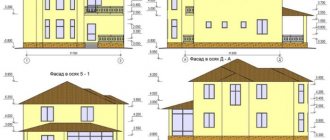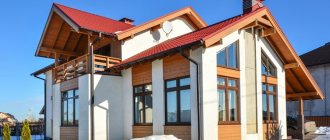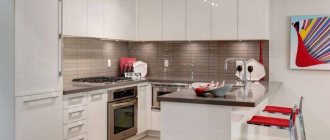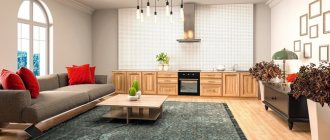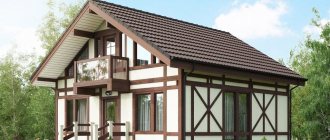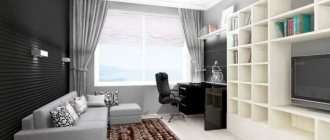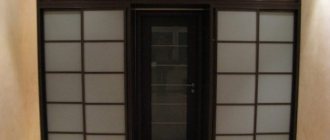Facade finishing
The texture of the natural material in the cladding and lighting affect the perception of color in different ways. The design elements must be in harmony with each other, creating a single ensemble. Stone and wood can be successfully combined with glass, mosaic or metal. The combinations of shades of the roof, façade and plinth are carefully thought out to create a holistic image of the building.
Typically, paint that is resistant to weather conditions and temperature changes is used to decorate plastered walls. For painting metal surfaces, steel, black paint is suitable. Metal alloys are coated with vinyl chloride or varnish.
Painting a brick building
The natural shade of the brick can be changed if desired. This is especially often used when updating the roof and basement. You can use different colors for modern style brick houses:
- Grey-white.
- Sand.
- Terracotta.
- Brown.
- Light grey.
Doing absolutely everything in a single composition is not the best solution. In a beautiful house, it is imperative to emphasize the foundation, porch, rustication and other elements of the facade.
Features of color selection
A competent specialist will help you decide which color is best to choose for the design of the facade. For selection, you can use special online programs. In any case, adopt some basic rules that will help you avoid common mistakes.
It is always better to go for lighter colors. Too bright, saturated and dark are more difficult to incorporate harmoniously into a space, and they quickly tire the eye.
Shades of the same range go well together: brown with beige, blue with light blue, etc. White is universal and goes with any shade.
Try to choose tones that are close to natural - this will provide you with the best combination of the color of the facade with nature and nearby buildings. Proper coloring will help to highlight the advantages of the finish and slightly smooth out the shortcomings.
When choosing a bright color, keep in mind that it will visually increase the size and make the house stand out from the surrounding background. Most often, warm yellow, brown, and red are used to paint walls.
You need to be careful with dark tones, using them in limited quantities. Quite popular are shades of green, which look very organic in the lap of nature and are perfect for country buildings.
A fashionable modern trend is the use of terracotta. You can choose both bright and calmer, muted shades that set you up for rest and relaxation. Using facade color catalogs, you will find a suitable solution.
A common option is brown-red tones, ranging from copper to chocolate. It is optimal to use them in the decoration of buildings with simple architecture.
Choose paint based on weather conditions and climate. Paint of organic origin tends to quickly fade from sunlight, and dark colors will increase the heating of the facade, which will lead to its accelerated destruction.
Harmony of white stucco and gray in the exterior of the house
Despite its gloominess, the gray tone in the exterior of a country house can symbolize homeliness and comfort. To do this, it is enough to beat it with a large amount of white decor.
Highlighting entrance lobbies, cornices, and windows with light colors dilutes the design of the facade. This will make the building welcoming and family-friendly.
A large amount of light, glass, open structures, outdoor recreation areas, and greenery are also welcome. The combination of green, white and gray colors in the exterior of the house is considered one of the most successful. Greens are usually used in landscape design and flower beds. Nature effectively brings the design to life.
Nuances of choosing a shade
Color creates a mood and affects the psycho-emotional state. It is better that its selection is carried out by professionals who will take into account all the nuances. However, you can easily understand how to choose the color of the facade yourself if you have at least a little experience in this.
The general rules are as follows
- the choice of shade is significantly influenced by the style in which the building is made - from classic to modern solutions;
- well-chosen tones will emphasize the style features and beauty of the building, while unsuccessful ones will neutralize the architectural features;
- for a building in a classic style, beige, white, milky shades are suitable;
- dark colors have the property of attracting sunlight and heat, so they are best used for buildings located in cold climates;
- take into account in advance the fact that bright colors fade faster in the sun;
- to highlight small elements, use light colors;
- rich and dark colors are best used if the building has a simple shape;
- dark tones highlight the shape of an object, light tones increase its volume.
The gray facade of a house in a cubic style as the basis for the urban design of a mansion
Architectural bureau Spaceworkers presented an ultra-modern house with a gray facade in a cubic style. The building's features are dominated by industrial motifs, and all this is emphasized by straight, strict forms made of monolithic reinforced concrete.
The building is cast as a single block of irregular shape and looks contrasting against the background of its natural surroundings. From the road it is constrained, strict and completely private, and from the backyard it is distinguished by friendliness and maximum openness due to continuous panoramic structures and integration with the environment.
Multicolor facade
For decoration, you can use several shades at once, provided they are properly combined. This option will draw attention to the building, and living in it can become more psychologically comfortable. If your project involves a combination of several tones, you need to take into account the nuances that will make this choice easier.
With the help of bright colors it is convenient to create an accent by painting windows and doors with them. Resort to the help of special architectural programs - this will allow you to significantly save time.
- Entrance doors to the house - which ones to choose? Review of the best models of 2022, design examples + 120 photos
- 8 by 8 house layout - the best design projects of 2022. Instructions for beginners + 100 design photos
- Advantages and disadvantages of metal siding
Evaluate the overall style of the building to choose the best combination. The facade and roof can be designed in the same color. Modern projects allow the use of interesting contrasts for these parts of the building. For example, a combination of black and yellow looks great.
It is better to paint wooden houses with glossy paints. But if the building is located in a sunny area, give preference to matte paint.
Simplicity of façade shapes and gray color in a cubic style
The main feature of cubism is the elementary nature of geometric forms in architecture and their spatial play. The gray monotonous color of the structures emphasizes their severity. At the same time, there are no decorative elements on the facade, and everything is planned with maximum rationality.
The solid gray facade covers the internal volume of the building, but at the same time does not look like a boring concrete wall due to the play of volumes. Changes, openings, blocks of different heights create an interesting architectural composition - as if you are looking at an object of modern art.
Using the gray facade of a house in a cubic style was a good idea in order to achieve harmony between the object and its surroundings, while contrasting it against the background of the blue sky and green landscape due to its visual resemblance to stone. At the same time, the architects emphasized the modernity of the mansion and emphasized its rationality.
| Architects | spaceworkers |
| Photo | Fernando Guerra | FG+SG |
Trendy Gray Exterior of Brazilian Housing
The construction and arrangement of a private house begins with the formation of a facade design. The exterior style can create an impeccable visual effect or, conversely, overshadow the building. Increasingly, architects give preference to restrained light colors and natural materials. For some, the gray facade of a house may seem boring, but not in the case of the Brazilian building from Beatriz Empinotti Arquitetura. The play of lines, shapes and contrasting colors helped transform the monotonous texture into a real Brazilian atmosphere of passion.
Huge volumes and shapes of the building were chosen for the construction of the house. This option made it possible to compactly arrange the bedrooms, living room, spacious dining room-kitchen, bathroom, lounge area, and home theater. In the courtyard, the outdoor area has been transformed into a screened veranda that is filled with natural light.
To finish the house's façade in gray, natural stone was chosen for the first floor and cast concrete for the second level. The concrete structure seems to protrude from the overall building, thereby transforming the structure into a modernist style. The part of the house overlooking the garden terrace is decorated with wooden panels. This material is in harmony with the general choice of natural cladding and natural texture.
An interesting solution was the entrance doors, which are completely disguised as a wooden panel. It is impossible to distinguish them from the general background, and this is another feature of the exterior design.
You can transform and visually enlarge the space of a building using cool shades. The architects could have chosen a modern way of finishing the exterior, but it would not have been able to convey the delicate sense of taste of the young homeowners. The uniquely designed gray facade of the house, the photo of which shows all the beauty of the building, is integrated in several shades.
Natural stone has a darker background with a relief surface, and the concrete protruding structure plays with the light lines of the walls. The upper floor plastically forms several folds, which, under different lighting angles, interestingly intertwine with the texture of the coating.
Against the background of the gray walls, bright furniture became a fresh breath of glamor. With black and white stone and monochrome concrete, the contrasting colors represent a mixture of Brazilian style and architectural understatement.
To prevent the facades of houses in gray tones from looking bulky, boring and primitive, you need to choose modern design trends - Scandinavian, country or modern. Contrasting zones will create a warm and soft exterior.
The front of the house is completely done in the selected gray color scheme. Entering the courtyard it seems that this is a completely different building. Wooden panels and bright furniture distract attention from the gray surfaces. To stay consistent with the main idea of the exterior, the architects used stone slabs for the terrace and light gray plaster on the walls.
The garden part of the area is perfect for arranging a terrace, where upholstered furniture in black, red and blue colors is located. The residential building is closed from the outside space, while residents can see all the beauty of the area through panoramic glazing.
Maximum lighting allows you to dilute the gray facade of the house, filling the walls with different shades. When choosing concrete or stone, the requirement for rich lighting is the main requirement.
The interior of the house, just like the exterior, is balancedly finished with gray and white plaster, black decorative elements, and bright furniture. The designers not only stuck to the main theme of a gray background, but also brought rich colors into the room.
| Architects | Beatriz Empinotti Arquitetura |
| Photo | Paula Morais |
Types of facade paints
Today, the market offers a wide range of compounds that have various properties. For example, to get a beautiful facade of a concrete house, you can use exterior paint with quartz sand or marble chips. With such a surface the structure will look more respectable.
A smooth aesthetic surface is provided by the following compositions:
Polyvinyl acetate or vinyl water-dispersed compositions that do not have a strong odor, but their durability is low. Such compositions are quite economical, but the painting of the house has to be renewed after about 3-4 years. You can also change the color at the same time. Therefore, it is better to make the first layer with a light pigment, and then add a rich shade later.
Silicate paint is an excellent option for painting the facade of a country house. They are produced on the basis of organosilicon compounds.
The composition is characterized by high adhesion, durability and strength; it can withstand hail and slanting rain, sudden temperature changes and exposure to direct sunlight. Fungi and mold, mosses and lichens do not grow on the treated surface.
Silicone compounds are relatively more expensive than previous analogues, but they are the most durable paint coatings. They are made on the basis of durable silane or siloxane, which repel dirt and water. Even near a busy road, the building will look clean.
Silicone-acrylic, acrylic, water-based and latex facade paints are produced on a water basis with the addition of elastic polymers. Under favorable weather conditions, the composition hardens quite quickly. Therefore, the expected effect can be achieved in 2-3 days if the surface of the house is coated with a primer and prepared for painting.
Note! If the house is located within the city, where there are buildings that have a certain historical value, it is important to coordinate its color, composition and overall design with the municipal authorities.
Recommendations
Before you start creating a bright facade of a private house, you must:
- Make a coloring, thanks to which you can choose the right shade. As practice shows, manufacturers of facade paint have different colors for the same color, which means you need to choose the shade correctly. You can solve the problem by purchasing several “samples” and carrying out preliminary painting on artistic foam board.
- Carry out a calculation that will allow you to determine the amount of paint needed. In the optimal case, it can be purchased from one manufacturer, so the problem of buying paint of different shades will not arise in principle.




